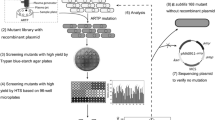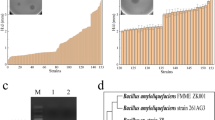Abstract
To improve fermentative production of α-amylase, heavy-ion mutagenesis technology was used to irradiate Bacillus subtilis (B. subtilis) to obtain the high yielding mutants in this study. After continuous cultivation for 12 generations, eight mutants exhibited positive mutation rate with greater H/C. The α-amylase production was stable and obviously exceeded that by the parent strain, which shows that the mutants have a good genetic stability. Among the mutants, the α-amylase activity of B. subtilis KC-180–2 was 72.26 U·mL−1, which was 82.34% higher than that of the original strain. After optimization of fermentation conditions and media, the α-amylase activity of B. subtilis KC-180–2 reached a maximum of 156.83 U·mL−1 at 36 h in a bioreactor. In addition, the optimized fermentation temperature of B. subtilis KC-180–2 was increased to 49℃, indicating B. subtilis KC-180–2 possesses high-temperature resistance, which has great application prospects for industrial fermentation for α-amylase production.









Similar content being viewed by others
Data Availability
All data generated or analyzed during this study are included in this published article.
References
Pandey, A., Nigam, P., Soccol, C. R., Soccol, V. T., & Mohan, R. (2000). Advances in microbial amylases. Biotechnology & Applied Biochemistry, 31(Pt 2), 135–152.
Khemakhem, B., Ali, M. B., Aghajari, N., Juy, M., Haser, R., & Bejar, S. (2009). Engineering of the α-amylase from Geobacillus stearothermophilus US100 for detergent incorporation. Biotechnology and Bioengineering, 102, 380–389.
Zafar A, Aftab MN, Iqbal I, ud Din Z, Saleem MA (2019) Pilot-scale production of a highly thermostable α-amylase enzyme from Thermotoga petrophila cloned into E. coli and its application as a desizer in textile industry. RSC Advances 9984–992.
Ma, M., & Du, J. (2006). Application of Bacillus subtilis enzyme in industrial production. Shandong Science, 19(3), 35–38.
Sundarram, A., & Murthy, T. P. K. (2014). α-amylase production and applications: A review. Journal of Applied & Environmental Microbiology, 2, 166–175.
Far, B. E., Ahmadi, Y., Khosroshahi, A. Y., & Dilmaghani, A. (2020). Microbial alpha-amylase production: Progress, challenges and perspectives. Advanced Pharmaceutical Bulletin, 10(3), 350–358.
Lu, J. (1988). Production of Bacillus subtilis α-amylase. Microbiology China, 15(4), 35–38.
Zhang, K., Tan, R., Yao, D., Su, L., Xia, Y., & Wu, J. (2021). Enhanced production of soluble Pyrococcus furiosus α-amylase in Bacillus subtilis through chaperone co-expression, heat treatment and fermentation optimization. Journal of Microbiology and Biotechnology, 31(4).
Al-Amri, A., Al-Ghamdi, M., Khan, J., Altayeb, H., Alsulami, H., Sajjad, M., Baothman, O., & Nadeem, M. (2021). Escherichia coli expression and characterization of α-amylase from Geobacillus thermodenitrificans DSM-465. Brazilian Journal of Biology, 82.
Vidyalakshmi, R., Paranthaman, R., & Indhumathi, J. (2009). Amylase production on submerged fermentation by Bacillus spp. World Journal of Chemistry, 4, 89–91.
Inthima, P., Otani, M., Hirano, T., Hayashi, Y., Abe, T., Nakano, M., & Supaibulwatana, K. (2014). Mutagenic effects of heavy-ion beam irradiation on in vitro nodal segments of Artemisia annua L. Plant Cell. Tissue and Organ Culture (PCTOC), 119, 131–139.
Chen, X., Feng, H., Du, Y., Luo, S., Li, W., Yu, L., Feng, Z., Cui, T., & Zhou, L. (2020). Genetic polymorphisms in mutagenesis progeny of Arabidopsis thaliana irradiated by carbon-ion beams and γ-rays irradiations. International Journal of Radiation Biology, 96, 267–275.
Li, H., Li, C., Ding, X., Wang, J., Zhou, G., Jie, H., Li, Q., Dang, B., Wen, X., & Li, W. (2004). Mutagenic effect of heavy ion irradiation on Rhodotorulaceae. Journal of Radiation Research and Radiation Technology, 27(1), 56–60.
Zhang N, Zhang B, Wang W, Xu J, Zhang D, Xue L (2012) Study on breeding of high yield poly-β-hydroxybutyrate strains by heavy ion mutagenesis. China Agricultural Science and Technology Herald, 95–100.
Dong, M., Wang, S., Xiao, G., Xu, F., Hu, W., Li, Q., Chen, J., & Li, W. (2019). Cellulase production by Aspergillus fumigatus MS13. 1 mutant generated by heavy ion mutagenesis and its efficient saccharification of pretreated sweet sorghum straw. Process Biochemistry, 84, 22–29.
Mefteh FB, Amal D, Ali CB, Alenezi FN, Lenka L, Rateb ME, Adel K, Neji G, Lassaad B (2017) Fungal root microbiome from healthy and brittle leaf diseased date palm trees (Phoenix dactylifera L.) reveals a hidden untapped arsenal of antibacterial and broad spectrum antifungal secondary metabolites. Frontiers in Microbiology 8, 307.
Dong, J., Li, Y., Xu, H., & Jiang, C. (2010). Optimization of microwave-assisted extraction process of total flavonoids from persimmon leaves using response surface methodology. Acta Agriculturae Zhejiangensis, 22, 521–526.
Fan-fan, Z., Fang, M., Xu-zhe, W., Kai-ting, T., & Chun-hui, M. (2018). Condition of fermentation combined with cellulose decomposing and lactic acid bacteria based on the response surface method. Pratacultural Science, 23(3), 703–711.
Yi, Z. (2016). Screening of high temperature resistant amylase-producing strains and research on enzyme production conditions and enzymatic properties. Doctoral dissertation, Hunan Agricultural University.
Song, X., Zhang, Y., Zhu, X., Wang, Y., Chu, J., & Zhuang, Y. (2017). Mutation breeding of high avermectin B 1a-producing strain by the combination of high energy carbon heavy ion irradiation and sodium nitrite mutagenesis based on high throughput screening. Biotechnology and Bioprocess Engineering, 22, 539–548.
Li, W., Zang, C., Li, Y., Tao, J., Pan, Z., Xu, K., Liang, Y., & Tong, Y. (2017). Research and application progress of α-amylase. Contemporary Chemical Industry, 46, 2292–2296.
Li J, Yang Q (2008) Research progress of Bacillus subtilis in Anhui. Anhui Agricultural Sciences, 106–111.
Rai, A. K., Sanjukta, S., Chourasia, R., Bhat, I., Bhardwaj, P. K., & Sahoo, D. (2017). Production of bioactive hydrolysate using protease, β-glucosidase and α-amylase of Bacillus spp. isolated from kinema. Bioresource technology, 235, 358–365.
Wang, L., Chen, Y., & Yang, L. (2017). Isolation and identification of Bacillus producing amylase. Food Research and Development, 38, 175r178.
Chen, X., Zhang, L., Zhang, J., & Zhou, L. (2008). Radiation mutagenesis of high yielding strain of Bacillus subtilis amylase. Journal of Radiation Research and Radiation Technology, 26(3), 177–182.
Ma, Y. F. (2016). Based on ARTP mutagenesis, directed transformation of expression elements and fermentation optimization to increase the level of recombinant alkaline amylase produced by Bacillus subtilis. Doctoral dissertation, Jiangnan University.
Park, S.-E., Seo, S.-H., Kim, E.-J., Na, C.-S., & Son, H.-S. (2018). Effects of different fermentation temperatures on metabolites of Kimchi. Food bioscience, 23, 100–106.
Tabatabaei Yazdi, F., Alizadeh Behbahani, B., Mohebbi, M., Mortazavi, S. A., & Ghaitaranpour, A. (2013). Effect of temperature on microbial changes during kimchi fermentation. Scientific Journal of Microbiology, 2(1).
Zhao, Y., Liu, S., & Chen, Y. (2017). Screening the Saccharomyces cerevisiae with high temperature toleranceby ARTP mutagenesis and genome shuffling. Modern Food Science & Technology, 11, 37–41.
Ding C, Shi F, Jiao G, QU J, QU L, Liu Z (2016) Optimization offermentation medium to produce the acid-resistant and thermostable α-amylase by Bacillus subtilis. Journal of Henan University of Technology 5.
Memetimin, H., Metqurban, E., Bughdash, A., Muhtar, D., & Tohty, D. (2017). Isolation of an α- amylase producing Bacillus and optimization of its fermentation conditions. Acta Scientiarum Naturalium Universitatis Sunyatseni, 56, 126–132.
Cui, G. (2013). Analysis of effects of initial medium volume on the fermentation production. Amino Acids & Biotic Resources, 35(1), 35–38
Zhang, D., Li, W., Song, S., & Hong, X. (2015). Optimization of fermentation conditions for mesophilic α-amylase production by Bacillus subtilis mutant XLG-51. Industrial Microbiology, 2015(2), 1–6.
Zhang, Q., Han, Y., & Xiao, H. (2017). Microbial α-amylase: A biomolecular overview. Process Biochemistry, 53, 88–101.
Suraiya, S., Kim, J. -H., Tak, J. Y., Siddique, M. P., Young, C. J., Kim, J. K., & Kong, I. -S. (2018). Influences of fermentation parameters on lovastatin production by Monascus purpureus using Saccharina japonica as solid fermented substrate. LWT - Food Science and Technology, 92(2), 1–9.
Wu, W. (2013). Fuel ethanol production using novel carbon sources and fermentation medium optimization with response surface methodology. International Journal of Agricultural and Biological Engineering, 6, 42–53.
Liu, M., Xie, M., Yang, Y., Liu, T., Du, L., Liang, Z., & Wei, Y. (2016). High level secretion expression of maltogenic α-amylase from Saccharomonosporaviridis in Bacillus subtilis. Guangxi Sciences, 23(1), 12–18.
Feng, J. (2010). Application and research advances of α-amylases. Modern Agricultural Science and Technology, 2010, 354–355.
Sui, W., & Liang, T. (1996). Research on application of high temperature resisting α-amylase in superhigh maltose syrup. Biotechnology, 6(2), 2.
Shiv, K. (2015). Role of enzymes in fruit juice processing and its quality enhancement[J]. Advances in Applied Science Research, 6(6), 114–124.
Souza, P. (2010). Magalhães P (2010) Application of microbial alpha-amylase in industry - A review. Brazilian Journal of Microbiology, 41(4), 850–861.
Demirci, A., Izmirlioglu, G., & Ercan, D. (2014). Fermentation and enzyme technologies in food processing, food processing: Principles and applications (2nd ed.). John Wiley & Sons, Ltd.
Hmidet, N., Jemil, N., & Nasri, M. (2019). Simultaneous production of alkaline amylase and biosurfactant by Bacillus methylotrophicus DCS1: Application as detergent additive. Biodegradation, 30, 247–258.
Gao Y, Wu B, Fu L, Liu J, He J (2016) Application of amylase in animal feed. Feed wide angle 5.
Luo, C., & Wei, Y. (2018). Progress in the classification and application of amylase. Guangxi Science, 25, 248–252.
Hagiwara, Y., Oike, T., Niimi, A., Yamauchi, M., Sato, H., Limsirichaikul, S., Held, K. D., Nakano, T., & Shibata, A. (2019). Clustered DNA double-strand break formation and the repair pathway following heavy-ion irradiation. Journal of radiation research, 60, 69–79.
Rong-fei, H., Yue-jin, W., Po, B., & Rong-fu, W. (2009). Studies on effects of low energy heavy ion implantation and model simulation. Review of Atomic Nuclear Physics, 26, 352–355.
Wang, J., Wang, J., Li, W., Luo, G., Yang, S., Du, Y., Wei, W., Jin, W., Luo, S., & Li, X. (2019). Photosynthetic response of Scenedesmus quadricauda to carbon ions irradiation. Acta Astronautica, 159, 27–32.
Acknowledgements
We are very grateful to researcher Bo Yu from the Institute of Microbiology, Chinese Academy of Sciences for providing the original strains. In addition, we thank the Institute of Modern Physics, Chinese Academy of Sciences for providing the heavy ion beam.
Funding
The work was supported by Inner Mongolia Major Science and Technology Projects (2019ZD021).
Author information
Authors and Affiliations
Contributions
Jin-na Cui and Zhan-ying Liu conceived and designed research. Jin-na Cui and Yan-xin Liu collected data and conducted experiments. Zhan-ying Liu provides research guidance, research funding, laboratories, and other material resources related to experiments. Jin-na Cui and Wei Hu wrote the draft paper, Jian-hua Hu, Yong-li Li revised the paper. Jin-na Cui had primary responsibility for final content. All authors read and approved the manuscript.
Corresponding author
Ethics declarations
Ethics Approval
Not applicable.
Consent to Participate
Not applicable.
Consent for Publication
Not applicable.
Competing Interests
The authors declare no competing interests.
Additional information
Publisher's Note
Springer Nature remains neutral with regard to jurisdictional claims in published maps and institutional affiliations.
Rights and permissions
Springer Nature or its licensor holds exclusive rights to this article under a publishing agreement with the author(s) or other rightsholder(s); author self-archiving of the accepted manuscript version of this article is solely governed by the terms of such publishing agreement and applicable law.
About this article
Cite this article
Cui, JN., Hu, W., Liu, YX. et al. Isolation and Screening of High-Yielding α-Amylase Mutants of Bacillus subtilis by Heavy Ion Mutagenesis. Appl Biochem Biotechnol 195, 68–85 (2023). https://doi.org/10.1007/s12010-022-04097-y
Accepted:
Published:
Issue Date:
DOI: https://doi.org/10.1007/s12010-022-04097-y




